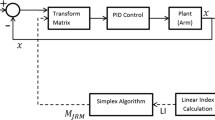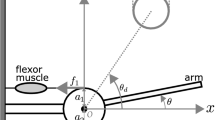Abstract
We predict the virtual trajectories and stiffness ellipses during multijoint arm movements by computer simulations. A two-link manipulator with four single-joint muscles and two double-joint muscles is used as a model of the human arm. Physical parameters of the model are derived from several experimental data. Among them, special emphasis is put on low values of the dynamic hand stiffness recently measured during single joint and multijoint movements. The feedback-error-learning scheme to acquire the inverse dynamics model and the inverse statics model is utilized for this prediction. The virtual trajectories are much more complex than the actual trajectories. This indicates that planning the virtual trajectory is as difficult as solving the inverse dynamics problem for medium and fast movements, and simply falsifies the advocated computational advantage of the virtual trajectory control hypothesis. Thus, we conclude that learning inverse models is essential even in the virtual trajectory control framework. Finally, we propose a new computational model to learn the complicated shape of the virtual trajectories by integrating the virtual trajectory control and the feedback-error-learning scheme.
Similar content being viewed by others
References
Abend W, Bizzi E, Morasso P (1982) Human arm trajectory formation. Brain 105:331–348
Amis AA, Dowson D, Wright V (1979) Muscle strengths and musculoskeletal geometry of the upper limb. Eng Med 8(1):41–48
Atkeson CG, Hollerbach JM (1985) Kinematic features of unrestrained vertical arm movement. J Neurosci 5:2318–2330
Atkeson CG, Reinkensmeyer DJ (1988) Using associative content addressable memories to control robots. In: Proceedings of the IEEE Conference on Decision and Control, pp 792–797
Bennett DJ (1991) Relationship between stiffness and net joint torque during ballistic elbow joint movement. Soc Neurosci Abstr 17:1029
Bennett DJ, Hollerbach JM, Xu Y, Hunter IW (1992) Time-varying stiffness of human elbow joint during cyclic voluntary movement. Exp Brain Res 88:433–442
Bizzi E, Polit A, Morasso P (1976) Mechanism underlying achievement of final head position. J Neurophysiol 39:435–444
Bizzi E, Accornero N, Chapple W, Hogan N (1984) Posture control and trajectory formation during arm movement. J Neurosci 4(11):2738–2744
Fel'dman AG (1966) Functional tuning of the nervous system with control of movement or maintenance of a steady posture. III. Mechanographic analysis of execution by man of the simplest motor tasks. Biophysics 11:766–775
Flash T (1987) The control of hand equilibrium trajectories in multi-joint arm movement. Biol Cybern 57:257–274
Flash T, Hogan N (1985) The coordination of arm movements: an experimentally confirmed mathematical model. J Neurosci 5(7):1688–1703
Flash T, Mussa-Ivaldi FA (1990) Human arm stiffness characteristics during the maintenance of posture. Exp Brain Res 82:315–326
Gomi H, Kawato M (1990) Learning control for a closed loop system using feedback-error-learning. In: Proceedings of the 29th IEEE Conference on Decision and Control, Hawaii, pp 3289–3294
Gomi H, Koike Y, Kawato M (1992) Human hand stiffness during discrete point-to-point multi-joint movement. Proc IEEE EMBS 1628–1629
Hatze H (1979) A model for the computational determination of parameter values of anthropomorphic segments. Technical report TWISK 79, National Research Institute for Mathematical Sciences, CSIR, South Africa
Hogan N (1984) An organizing principle for a class of voluntary movements. J Neurosci 4(11):2745–2754
Hogan N (1985) The mechanics of multi-joint posture and movement control. Biol Cybern 52:315–331
Houk JC, Rymer WZ (1981) Neural control of muscle length and tension. In: Brookhart JM, Mountcastle VB, Brooks VB, Geiger SR (eds) Handbook of physiology, vol 2. American Physiological Society, Bethesda, Md, pp 257–323
Jordan MI, Rumelhart MI (1992) Forward models: supervised learning with a distal teacher. Cognitive Sci 16:307–354
Joyce GC, Rack PMH, Westbury DR (1969) The mechanical properties of cat soleus muscle during controlled lengthening and shortening movements. J Physiol (Lond) 204:461–474
Katayama M, Kawato M (1991a) Learning trajectory and force control of an artificial muscle arm by parallel-hierarchical neural network model. In: Lippmann RP, Moody JE, Touretzky DS (eds) Advances in neural information processing systems, vol 3. Morgan Kaufmann, San Mateo, Calif, pp 436–442
Katayama M, Kawato M (1991b) Virtual trajectory and stiffness ellipse during force-trajectory control using a parallel-hierarchical neural network model. In: Fifth International Conference on Advanced Robotics, Pisa, Italy, pp 1187–1194
Katayama M, Kawato M (1992) Virtual trajectory and stiffness ellipse during multi-joint arm movement predicted by neural inverse models, ATR Technical Report TR-A-0144
Kawato M (1992) Optimization and learning in neural networks for formation and control of coordinated movement. In: Meyer D, Kornblum S (eds) Attention and performance, XIV: synergies in experimental psychology, artificial intelligence, and cognitive neuroscience — a silver jubilee. MIT Press, Cambridge, Mass, pp 821–849
Kawato M, Furukawa K, Suzuki R (1987) A hierarchical neural-network model for control and learning of voluntary movement. Biol Cybern 57:169–185
Lacquaniti F, Licata F, Soeching JF (1982) The mechanical behavior of the human forearm in response to transient perturbations. Biol Cybern 44:35–46
MacKay WA, Crammond DJ, Kwan HC, Murphy JT (1986) Measurements of human forearm viscoelasticity. J Biomech 19(3):231–238
Miller WT (1987) Sensor-based control of robotic manipulators using a general learning algorithm. IEEE J Robotics Automation 3:157–165
Morasso P (1981) Spatial control of arm movements. Exp Brain Res 42:223–227
Mussa-Ivaldi FA, Hogan N, Bizzi E (1985) Neural, mechanical, and geometric factors subserving arm posture in humans. J Neurosci 5(10):2732–2742
Özkaya N, Nordin M (1991) Fundamentals of biomechanics: equilibrium, motion, and deformation. Van Nostrand Reinhold, New York
Polit A, Bizzi E (1979) Characteristics of the motor programs underlying arm movements in monkeys. J Neurophysiol 42:183–194
Rack PMH, Westbury DR (1969) The effects of length and stimulus rate on tension in the isometric cat soleus muscle. J Physiol (Lond) 204:443–460
Sanger T (1992) Learning inverse dynamics by local exploration. Abstr Neural Networks for Computing Snowbird, Utah
Tsuji T, Ito K, Nagamachi M, Ikemoto T (1988) Impedance regulations in musculo-motor control system and the manipulation ability of the end-point. SICE 24(4):385–392 (in Japanese)
Uno Y, Kawato M, Suzuki R (1989) Formation and control of optimal trajectory in human multijoint arm movement: minimum-torque-change model. Biol Cybern 61:89–101
Wood JE, Meek SG, Jacobsen SC (1989a) Quantitation of human shoulder anatomy for prosthetic arm control. I. Surface modeling. J Biomech 22(3):273–292
Wood JE, Meek SG, Jacobsen SC (1989b) Quantitation of human shoulder anatomy for prosthetic arm control. II. Anatomy matrices. J Biomech 22(4):309–325
Author information
Authors and Affiliations
Rights and permissions
About this article
Cite this article
Katayama, M., Kawato, M. Virtual trajectory and stiffness ellipse during multijoint arm movement predicted by neural inverse models. Biol. Cybern. 69, 353–362 (1993). https://doi.org/10.1007/BF01185407
Received:
Accepted:
Issue Date:
DOI: https://doi.org/10.1007/BF01185407




